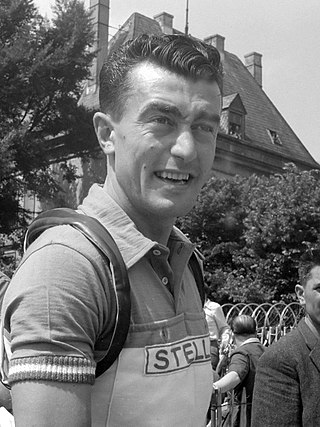
Louis "Louison" Bobet was a French professional road racing cyclist. He was the first great French rider of the post-war period and the first rider to win the Tour de France in three successive years, from 1953 to 1955. His career included the national road championship, Milan–San Remo (1951), Giro di Lombardia (1951), Critérium International, Paris–Nice (1952), Grand Prix des Nations (1952), world road championship (1954), Tour of Flanders (1955), Critérium du Dauphiné Libéré (1955), Tour de Luxembourg (1955), Paris–Roubaix (1956) and Bordeaux–Paris (1959).

Angelo Fausto Coppi was an Italian cyclist, the dominant international cyclist of the years after the Second World War. His successes earned him the title Il Campionissimo. He was an all-round racing cyclist: he excelled in both climbing and time trialing, and was also a good sprinter. He won the Giro d'Italia five times, the Tour de France twice, and the World Championship in 1953. Other notable results include winning the Giro di Lombardia five times, the Milan–San Remo three times, as well as wins at Paris–Roubaix and La Flèche Wallonne and setting the hour record (45.798 km) in 1942.
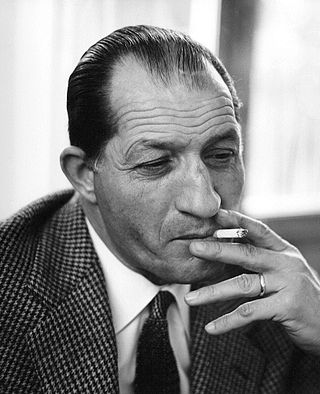
Gino Bartali,, nicknamed Gino the Pious and Ginettaccio, was a champion road cyclist. He was the most renowned Italian cyclist before the Second World War, having won the Giro d'Italia twice, in 1936 and 1937, and the Tour de France in 1938. After the war, he added one more victory in each event: the Giro d'Italia in 1946 and the Tour de France in 1948. His second and last Tour de France victory in 1948 gave him the largest gap between victories in the race.

The mountains classification is a secondary competition in the Tour de France, that started in 1933. It is given to the rider that gains the most points for reaching mountain summits first. The leader of the classification is named the King of the Mountains, and since 1975 wears the polka dot jersey, a white jersey with red polka dots.

Hugo Koblet was a Swiss champion cyclist. He won the Tour de France and the Giro d'Italia as well as competing in six-day and pursuit races on the track. He won 70 races as a professional. He died in a car accident amid speculation that he had committed suicide.

Claudio Chiappucci is a retired Italian professional cyclist. He was on the podium three times in the Tour de France general classification: second in 1990, third in 1991 and second again in 1992.

The 1952 Tour de France was the 39th edition of the Tour de France, taking place from 25 June to 19 July. It was composed of 23 stages over 4,807 km (2,987 mi). Newly introduced were the arrivals on mountain peaks.

The 1949 Tour de France was the 36th edition of the Tour de France, taking place from 30 June to 24 July. It consisted of 21 stages over 4,808 km (2,988 mi).

Kim Kirchen is a Luxembourgish former road racing cyclist. He is the son of cyclist Erny Kirchen and the great-nephew of cyclist Jeng Kirchen.

Jean Robic was a French road racing cyclist who won the 1947 Tour de France. Robic was a professional cyclist from 1943 to 1961. His diminutive stature and appearance was encapsulated in his nickname Biquet(Kid goat). For faster, gravity-assisted descents, he collected drinking bottles ballasted with lead or mercury at the summits of mountain climbs and "cols". After fracturing his skull in 1944 he always wore a trademark leather crash helmet.

The 1953 Tour de France was the 40th edition of the Tour de France, taking place from 3 to 26 July. It consisted of 22 stages over 4,476 km (2,781 mi).
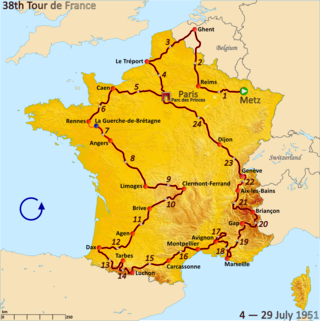
The 1951 Tour de France was the 38th edition of the Tour de France, taking place from 4 to 29 July. It consisted of 24 stages over 4,690 km (2,914 mi). The race started outside Île-de-France for the first time since 1926; a change that remained permanent beyond 1951 with the exceptions of 1963, 1983, 1984, 1986 and 2003.
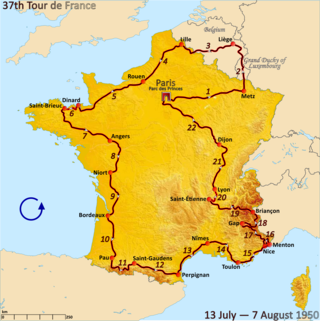
The 1950 Tour de France was the 37th edition of the Tour de France, taking place from 13 July to 7 August. It consisted of 22 stages over 4,773 km (2,966 mi).

The 1948 Tour de France was the 35th edition of the Tour de France, taking place from 30 June to 25 July 1948. It consisted of 21 stages over 4,922 km (3,058 mi).

Raphaël Géminiani was a French road bicycle racer. He had three podium finishes in the Grand Tours. He was one of four children of Italian immigrants who moved to Clermont-Ferrand fleeing from fascist violence. He worked in a cycle shop and started racing as a boy. He became a professional and then a directeur sportif, notably of Jacques Anquetil and the St-Raphaël team.

André Mahé was a French road bicycle racer. He was born in Paris, France. He was a professional rider from 1945 until 1954. He jointly won the 1949 classic cycle race Paris–Roubaix with Serse Coppi in controversial fashion. In 1950 he won the classic Paris–Tours race.
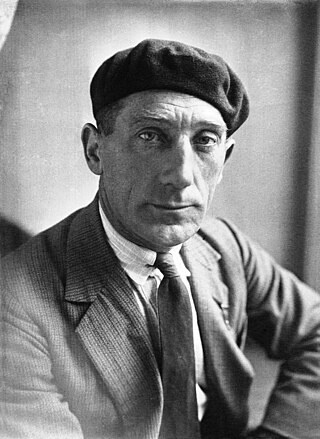
Victor Fontan was a French cyclist who led the 1929 Tour de France but dropped out after knocking at doors at night to ask for another bicycle. His plight led to a change of rules to prevent its happening again. He was also one of three riders who all wore the yellow jersey of leadership on the same day, the only time it has happened.
Pierre Chany was a French cycling journalist. He covered the Tour de France 49 times and was for a long time the main cycling writer for the daily newspaper, L'Équipe.
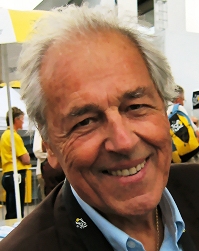
Jacques Augendre is a French journalist and the first to have followed fifty Tours de France. Jacques Goddet covered 53 but from 1936 to 1986 he was also the race organiser. Pierre Chany would have been the first journalist to 50 Tours de France had he not died in 1996 within weeks of the start.


















